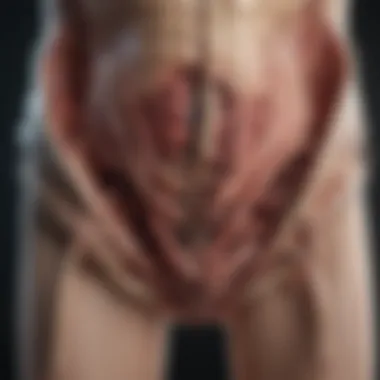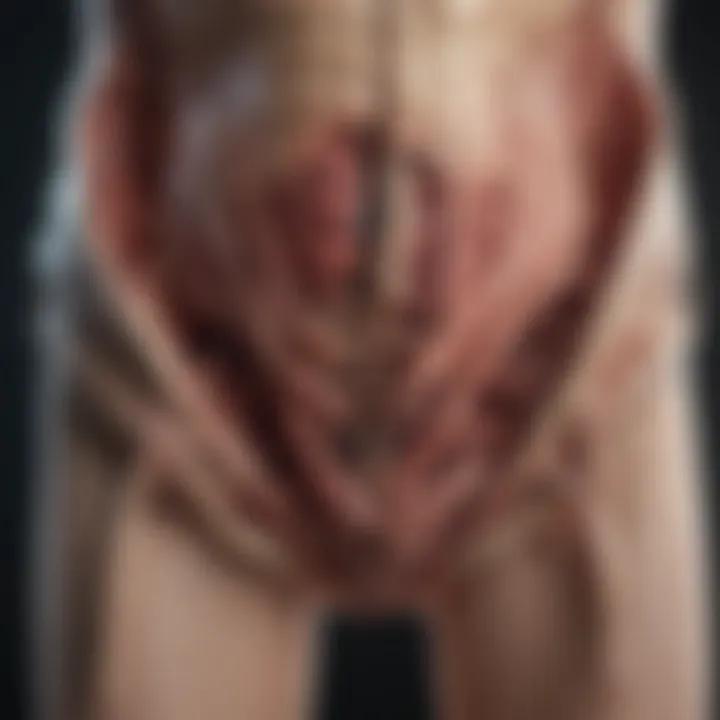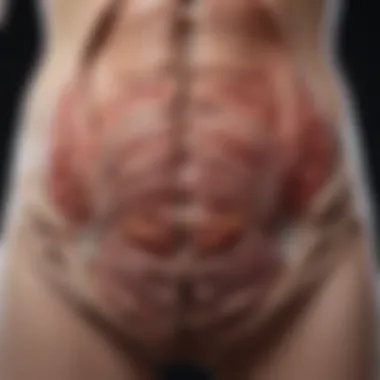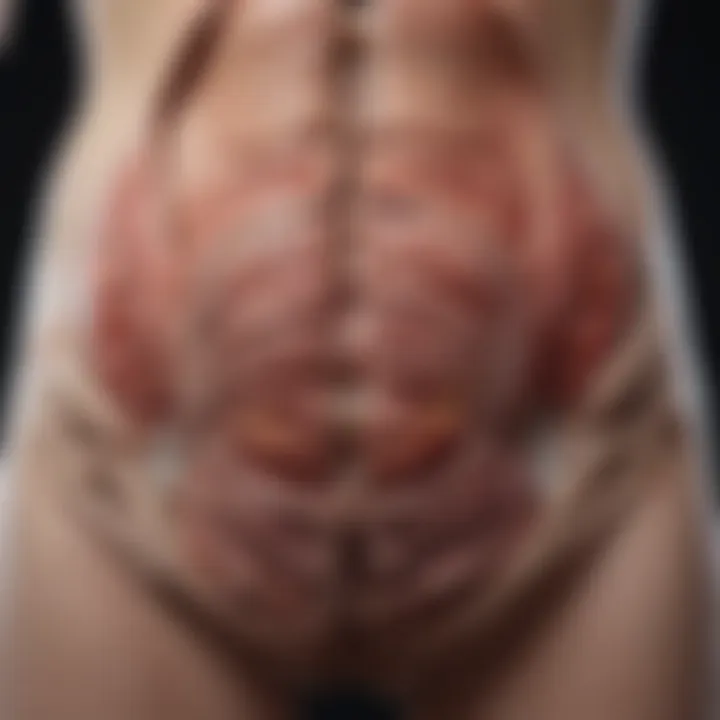Understanding Sacral Wounds: Treatment and Management


Intro
Sacral wounds represent a significant challenge in both clinical practice and research. These wounds typically arise in areas vulnerable to pressure, friction, and shear forces. They are often linked to prolonged periods of immobility, making them a prominent concern in patients with limited mobility, including those with spinal cord injuries, neurodegenerative diseases, and other conditions that affect mobility.
In understanding sacral wounds, it is critical to consider a variety of factors that contribute to their formation. These include patient-specific factors such as age, nutritional status, and underlying health conditions. Additionally, external factors such as bedding quality and patient repositioning also play a role.
This article aims to provide a thorough examination of sacral wounds, covering not only their causes but also effective treatment and management strategies. By gaining insight into this multifactorial issue, healthcare professionals can improve patient outcomes and elevate the standards of care.
Article Overview
Purpose of the Article
The primary purpose of this article is to comprehensively explore the complexities of sacral wounds. It seeks to inform readers about their etiology, clinical explanation, and the evolving landscape of treatment options. By presenting evidence-based best practices, the article aims to serve as a valuable resource for healthcare professionals, researchers, and educators involved in wound management.
Relevance to Multiple Disciplines
Sacral wounds attract attention from various health disciplines, including nursing, physical therapy, and preventive medicine. Their management requires an interdisciplinary approach that encompasses:
- Assessment of risk factors: Understanding which patients are at risk is essential for prevention.
- Multimodal treatment strategies: These may include pressure relief, nutritional optimization, and surgical interventions.
- Rehabilitative care: Involves coordinating efforts among specialists to aid recovery.
Given the prevalence of sacral wounds in various patient populations, knowledge in this field is beneficial across multiple healthcare settings.
Research Background
Historical Context
The study of wounds, particularly sacral wounds, has evolved considerably over the decades. Initially, wound care relied heavily on antiseptic techniques and basic dressings. Over time, advancements have led to more sophisticated treatments and an understanding of wound healing dynamics. Literature from the early 20th century highlights the role of hygiene and positioning in wound prevention, laying the groundwork for modern techniques.
Key Concepts and Definitions
Several key concepts are crucial for understanding sacral wounds:
- Pressure Ulcer: A wound resulting from unrelieved pressure, typically over bony prominences, leading to tissue damage.
- Shear: A force that causes the layers of skin to slide over one another, which can damage blood vessels.
- Ischemia: Inadequate blood supply to tissues, often a factor in wound formation.
A clear grasp of these concepts enhances our ability to address sacral wounds effectively, underpinning the importance of ongoing education and research.
Preface to Sacral Wound
Understanding the complexities surrounding sacral wounds is crucial for healthcare professionals. Sacral wounds, often categorized as pressure ulcers or decubitus ulcers, signify significant medical concern. Their relevance extends beyond just the physical aspect; they can impact a patient’s psychological well-being and overall quality of life. Furthermore, these wounds provide insight into broader healthcare issues, such as patient mobility and systemic health conditions.
Given the high frequency of sacral wounds in certain patient populations, particularly among the elderly or those with limited mobility, it is imperative to address the specific elements that contribute to their development. Key factors include mechanical forces, vulnerability of the skin in the sacral region, and the influence of underlying health issues. Understanding these aspects enables healthcare providers to implement effective prevention and treatment strategies.
This section will detail the definition and characteristics of sacral wounds, as well as their prevalence in various populations.
Definition and Characteristics
A sacral wound is primarily defined as an injury to the skin and underlying tissues over the sacrum, typically occurring due to prolonged pressure. The skin may appear discolored initially and can progress to deeper tissue damage if not addressed promptly. Characteristics of these wounds include:
- Location: Usually found at the sacral area, often near bony prominences.
- Stage progression: These wounds are classified into several stages; from non-blanchable erythema to full-thickness tissue loss.
- Pain and discomfort: Patients often report pain or discomfort associated with these injuries.
Understanding these characteristics is essential for effective assessment and management.
Prevalence and Epidemiology
The prevalence of sacral wounds highlights their impact on specific patient demographics. Studies indicate significant rates of occurrence in:
- Long-term care facilities: Patients in these settings often have limited mobility, putting them at higher risk.
- Acute care hospitals: Data suggests that sacral wounds develop in approximately 8-22% of hospitalized patients.
- Home care: Vulnerable individuals receiving in-home support may also develop these wounds due to insufficient care.
The epidemiology of sacral wounds underscores the need for targeted interventions. Understanding the demographics most affected can guide resource allocation for prevention and treatment.
"Effective management of sacral wounds requires an understanding of their defining characteristics and the populations at risk."
"Effective management of sacral wounds requires an understanding of their defining characteristics and the populations at risk."
In summary, the exploration of sacral wounds is significant as it lays the groundwork for subsequent sections on pathophysiology, diagnostics, and treatments.


Anatomical Considerations
Understanding the anatomical aspects of the sacral area is crucial when discussing sacral wounds. The sacrum is a significant structure in the human body, playing a role in weight distribution and mobility. Recognizing its complexities aids healthcare professionals in both assessment and treatment strategies for wounds that occur in this region.
Sacral Anatomy Overview
The sacrum is a triangular bone located at the base of the spine, forming a vital part of the pelvis. This bone is comprised of five fused vertebrae that articulate with the lumbar vertebrae above and the coccyx below. The sacral canal houses nerves that extend to the lower extremities. Additionally, the multiple foramina on the sacrum allow for the exit of sacral nerves and blood vessels.
An important consideration is the overlying skin and subcutaneous tissues, which are often vulnerable to pressure and shear forces, leading to the formation of sacral wounds. Understanding the landmarks of the sacral region, including the posterior superior iliac spines, can assist clinicians in identifying potential risk factors for injuries as well as in surgical interventions.
The sacrum also serves as a point of attachment for various ligaments, muscles, and fascia that impact stability and mobility. This anatomical significance highlights the need for comprehensive evaluation in patients susceptible to pressure injuries in this area.
Biomechanics of the Sacral Area
Biomechanical factors are essential when examining sacral wounds, as they directly relate to how forces act on the sacral region. The sacrum supports the upper body’s weight, impacting how pressure is distributed across the pelvis and lower spine during various activities like sitting, standing, or moving.
Pressure injuries often arise from sustained pressure that exceeds the capillary perfusion pressure over bony prominences, leading to ischemia and tissue necrosis. Recognizing these biomechanical conditions helps in both the prevention and management of sacral wounds.
"Effective management of sacral wounds depends on understanding both anatomical and biomechanical factors that contribute to their development."
"Effective management of sacral wounds depends on understanding both anatomical and biomechanical factors that contribute to their development."
Factors like body mass index, mobility, and the distribution of weight can influence these wounds' likelihood and severity. To mitigate risks, patients should be frequently repositioned, and appropriate cushioning techniques should be employed, especially for individuals with limited mobility.
In summary, the anatomical and biomechanical perspectives of the sacrum provide a foundational understanding necessary for effective clinical assessment and intervention. By grasping these complexities, healthcare providers can better address the challenges associated with sacral wounds.
Etiology of Sacral Wounds
Understanding the etiology of sacral wounds is paramount in addressing this clinical issue effectively. Etiology refers to the underlying causes and factors contributing to the development of these wounds. Knowledge of these aspects allows healthcare professionals to create targeted prevention and treatment strategies. It is essential to recognize that sacral wounds don't arise from a single cause but are influenced by various mechanical, dermal, and systemic factors. This section will detail these influences to provide readers with clarity on how to approach sacral wound management.
Mechanical Factors Influencing Wound Formation
Mechanical factors play a significant role in the formation of sacral wounds. These include shear, friction, and pressure. Shear occurs when the skin moves in one direction while the underlying tissues move in another. This can lead to skin breakdown, particularly in patients with limited mobility.
Friction results when two surfaces rub against each other and can damage the skin, making it more susceptible to wounds. Pressure, especially over bony prominences such as the sacrum, can reduce blood flow to the area and impair oxygenation and nutrient delivery to the skin, leading to tissue necrosis.
Preventing these mechanical forces is crucial. Techniques such as repositioning patients regularly and using pressure-relieving devices can minimize the risk. Understanding these mechanical dynamics is vital for effective management of sacral wounds.
Dermal and Subdermal Changes
Changes in the dermal and subdermal layers of skin can predispose individuals to sacral wounds. Aging, for example, leads to thinner skin, reduced elasticity, and diminished blood supply, all of which contribute to increased vulnerability. In individuals with certain medical conditions, like diabetes or vascular disease, the dermis can become compromised.
Moreover, moisture can also lead to skin breakdown through maceration. Excess moisture from incontinence or wound exudate can weaken the skin's integrity. It is crucial to assess the condition of the skin regularly. Interventions such as keeping the skin clean and dry can be effective preventive measures.
Systemic Conditions Contributing to Sacral Wounds
Several systemic conditions contribute to the risk of developing sacral wounds. For instance, conditions causing impaired mobility, like stroke or neurological disorders, significantly increase the likelihood of wound formation. Furthermore, chronic illnesses, including renal failure and heart disease, can complicate healing.
Nutritional status also affects wound healing. Malnutrition impairs the body's ability to regenerate tissue, making individuals more prone to sacral wounds. Consequently, assessing and addressing these systemic factors is vital for improving outcomes. Regular monitoring of patients' health status and nutritional needs can help manage and mitigate the risks associated with sacral wounds.
Understanding the etiology of sacral wounds can lead to more effective prevention strategies and better patient outcomes.
Understanding the etiology of sacral wounds can lead to more effective prevention strategies and better patient outcomes.
Clinical Assessment and Diagnosis
Clinical assessment and diagnosis play a crucial role in understanding sacral wounds. The intricacies of these wounds necessitate a comprehensive evaluation, which can directly influence treatment and management strategies. Effective assessment allows healthcare professionals to identify the specific characteristics of the wound, its stage, and underlying causes, enabling the development of tailored intervention plans. Accurate diagnosis is not merely beneficial; it is essential for improving patient outcomes and facilitating targeted therapies.
Visual Inspection and Grading
Visual inspection is the preliminary step in clinical assessment. It involves closely examining the wound and surrounding tissues to gather valuable data on its size, depth, and appearance. Several grading systems, such as the National Pressure Ulcer Advisory Panel (NPUAP) classification, can help categorize the wound and determine its severity. Grading informs both immediate care and long-term strategies, guiding practitioners on the necessary interventions. Observing features like exudate, necrosis, and odor also contributes to an effective grading process. Regular inspections enable tracking of changes over time, critical for assessing response to treatment.
Diagnostic Imaging Techniques
Diagnostic imaging serves as an adjunct to visual assessment, offering deeper insights into the wound characteristics. Techniques like ultrasound, X-rays, and MRI can reveal underlying issues not visible externally. For instance, ultrasound can assess tissue viability, while X-rays help identify bone involvement. MRI is particularly useful for complex cases, providing detailed images of the sacral region. These imaging modalities support clinicians in crafting appropriate surgical plans or other interventions when necessary. The use of diagnostic imaging thus enhances the overall accuracy of assessment, which is vital for effective management.
Risk Assessment Tools


Identifying patients at risk for developing sacral wounds is a key component of clinical assessment. Various risk assessment tools, such as the Braden Scale, evaluate physiological and sensory aspects that contribute to wound formation. This tool incorporates factors such as mobility, moisture, and friction, assigning scores that indicate overall risk levels. By employing risk assessment tools, healthcare teams can proactively implement preventative measures tailored to individual patient needs. Understanding each patient's risk factors establishes strategies conducive to reducing the incidence of sacral wounds and improving care quality.
Key Takeaway: Clinical assessment and diagnosis are foundational in managing sacral wounds. They enable tailored treatment approaches, which are critical for effective patient care.
Key Takeaway: Clinical assessment and diagnosis are foundational in managing sacral wounds. They enable tailored treatment approaches, which are critical for effective patient care.
Management Strategies for Sacral Wounds
Management strategies for sacral wounds are pivotal in ensuring effective healing and minimizing complications. These wounds typically arise from prolonged pressure, often seen in patients with limited mobility. Addressing their management involves both preventive and active treatment methodologies. Improving patient outcomes relies heavily on integrating various strategies tailored to individual needs. Key elements here include understanding wound care protocols, surgical interventions, and exploring innovative therapies.
Wound Care Protocols
Implementing effective wound care protocols is critical in managing sacral wounds. These protocols guide healthcare providers on how best to treat and care for the wound, emphasizing cleanliness and moisture balance. Basic wound care practices include:
- Regular cleaning: Utilizing saline solutions to cleanse the wound can help reduce the risk of infection.
- Dressing selection: Choosing appropriate dressings based on the wound's condition is crucial. Hydrocolloid dressings, for example, offer moisture retention and protection against external contaminants.
- Assessment of wound progress: Regular monitoring ensures that healing progresses. Marking the wound edges can help in tracking changes over time.
Regular assessment and timely adjustment of care protocols are crucial for optimal healing outcomes.
Regular assessment and timely adjustment of care protocols are crucial for optimal healing outcomes.
Integrating education for patients and caregivers enhances compliance with care routines, fostering better management of these complex wounds.
Surgical Intervention Techniques
Surgical interventions may become necessary when wounds do not respond adequately to conservative care. Techniques can vary based on the wound's severity and underlying issues. Key methods include:
- Debridement: This involves the surgical removal of necrotic tissue, facilitating healthier tissue growth and reducing bacterial load.
- Flap reconstruction: In cases of significant tissue loss, flap procedures can be used to cover the defect. This technique enhances vascularization to the area and accelerates healing.
- Skin grafting: Skin grafts may also be utilized especially when the wound has reached more advanced stages.
Each surgical option carries specific risks and benefits. Proper patient selection and thorough preoperative assessment remain vital to enhance surgical outcomes in sacral wound management.
Innovative Therapies in Treatment
Emerging therapies play an invaluable role in the advancement of sacral wound treatment. Innovations aim to improve healing times and patient quality of life. Recent advancements include:
- Negative pressure wound therapy: This method utilizes suction to promote wound healing, reducing edema and enhancing blood flow.
- Biologic dressings and grafts: Using skin substitutes derived from human or porcine tissues can facilitate healing in difficult wounds.
- Growth factor therapies: These therapies employ naturally occurring proteins to promote healing in stalled wounds.
Innovations continually reshape the landscape of wound management, providing healthcare professionals with new tools to combat the challenges of sacral wound healing.
Rehabilitation and Patient Management
Rehabilitation and patient management are crucial aspects of addressing sacral wounds. These wounds often result from a combination of factors, such as immobility, pressure, and underlying health conditions. Effective management of sacral wounds does not end with treatment; rather, rehabilitation plays a vital role in promoting healing and preventing recurrence. The aim is to enhance the patient's overall well-being and restore their functional abilities.
Specific Elements of Rehabilitation
Key elements of rehabilitation include physical therapy and nutritional support. Each component addresses the multi-dimensional needs of the patient.
Benefits of Rehabilitation
- Improved Mobility: Physical therapy focuses on restoring strength and mobility. Patients learn exercises that facilitate movement, decreasing reliance on assistive devices.
- Pressure Relief: Therapists work with patients to develop techniques for pressure relief. This includes strategies for changing positions frequently to alleviate stress on the sacral area.
- Psychological Support: Rehabilitation also includes psycho-social support. Patients may experience anxiety or depression due to their condition. Therapy sessions can address these emotional challenges, contributing to an overall positive recovery experience.
- Education: Patients and caregivers are educated about lifestyle changes that encourage healing and prevent wound recurrence.
Considerations
When implementing a rehabilitation program, it’s vital to personalize the approach based on the patient's needs. The extent of the wound, general health, age, and mobility levels all influence rehabilitation strategies. Continuous assessment ensures that the program adapts as the patient progresses.
Physical Therapy Options
Physical therapy plays an integral role in the rehabilitation process for patients with sacral wounds. Various options are available to cater to different needs.
- Therapeutic Exercises: These include range-of-motion exercises that are pivotal for those confined to a bed or wheelchair.
- Strength Training: Even light resistance training can significantly benefit patients by improving strength, which supports healing.
- Massage Therapy: This option can enhance blood circulation and facilitate tissue regeneration, promoting wound healing.
- Mobility Aids Training: Learning how to safely use wheelchairs, walkers, or other devices can enhance independence while minimizing the risk of pressure injuries.
Nutritional Considerations in Healing
Nutrition is fundamental for the healing process of sacral wounds. An adequate intake of nutrients ensures the body can repair damaged tissues effectively.
- Protein: Essential for cellular repair, adequate protein consumption is vital for wound healing.
- Vitamins and Minerals: Vitamins A and C, along with zinc, are particularly important for skin health and healing.
- Hydration: Proper hydration supports nutrient absorption and the skin’s elasticity.
- Balanced Diet: A well-rounded diet helps in maintaining a healthy body weight, which can alleviate pressure on the sacral area.
In summary, rehabilitation and patient management should not be seen as ancillary components of treating sacral wounds. Instead, they are foundational to effective recovery, encompassing physical therapy and nutritional support that enhance healing and promote overall patient well-being.
Complications Associated with Sacral Wounds


Understanding complications linked to sacral wounds is crucial in managing patient health effectively. These complications may arise during the course of treatment or may emerge as a result of the wound itself. Recognizing these potential issues allows healthcare providers to implement timely interventions, thereby reducing overall morbidity. The implications of unmanaged complications can profoundly affect patient outcomes, emphasizing the importance of this discussion.
Infection Risk and Management
Infection is perhaps the most significant risk associated with sacral wounds. The sacral area is particularly vulnerable due to its anatomical structure and the high degree of pressure it experiences. Factors such as moisture, insufficient blood supply, and external contaminants can contribute to an environment conducive to infection.
Common infections include:
- Bacterial infections: These can lead to cellulitis or abscess formation, complicating healing.
- Fungal infections: More common in patients with moisture exposure or immunocompromised states.
Management of infection involves several critical steps:
- Assessment: Regular monitoring for signs of infection, such as increased redness, warmth, and discharge, is essential.
- Culturing: If infection is suspected, cultures should be obtained to identify the specific pathogen.
- Antibiotic Therapy: Initiating appropriate antibiotic treatment based on sensitivity results helps mitigate infection.
- Local Wound Care: Maintaining a clean and dry environment around the wound is paramount in preventing infection.
- Surgical Intervention: In some cases, surgical debridement may be necessary to remove infected tissue.
Effective infection management not only prevents progression but also promotes optimal healing, which is essential for overall recovery.
Impact on Quality of Life
Sacral wounds can have a profound impact on a patient's quality of life. These wounds often cause significant discomfort, pain, and psychological distress. The physical limitations imposed by the wound can restrict mobility and independence, affecting daily activities and social interactions.
Factors contributing to decreased quality of life include:
- Pain and Discomfort: Continuous pain from the wound can lead to chronic pain syndromes, impacting overall well-being.
- Psychological Effects: Anxiety or depression may arise due to the chronic nature of the wound, leading to social isolation.
- Functional Limitations: Difficulty in moving can hinder a person's ability to perform basic self-care tasks, causing frustration and dependence on others.
Addressing the quality of life issues associated with sacral wounds is essential in holistic patient care. Healthcare strategies should include:
- Providing pain management therapies.
- Encouraging mental health support through counseling or support groups.
- Employing rehabilitation efforts aimed at enhancing mobility and self-care capacity.
Ultimately, managing complications linked to sacral wounds requires a multidimensional approach that prioritizes infection prevention and enhances patient quality of life. This holistic view is vital for optimizing patient care and improving treatment outcomes.
Emerging Research and Future Directions
The exploration of sacral wounds is continually evolving, and this section addresses current developments in research and future directions in treatment strategies. Understanding emerging trends and precisely focusing on potential areas for further investigation is crucial for managing sacral wounds effectively. This could lead to enhanced recovery rates and improved quality of life for patients, making it a vital subject for healthcare professionals and researchers alike.
Current Trends in Sacral Wound Research
Recent studies highlight innovative approaches to both the diagnosis and treatment of sacral wounds. One significant trend includes the integration of technology in wound management. For instance, the use of advanced imaging techniques allows for more accurate assessments of wound depth and condition. Moreover, smart dressings that monitor healing stages and provide data for better clinical decisions are becoming more widespread.
Additionally, researchers are investigating the role of biologics in wound healing. These include growth factors that promote tissue regeneration, as well as bioengineered skin substitutes that can serve as temporary wound coverings. Recent clinical trials have shown promising results, indicating that such products may reduce healing times and minimize complications.
"The innovation in sacral wound treatment promises a shift towards more personalized and effective care strategies."
"The innovation in sacral wound treatment promises a shift towards more personalized and effective care strategies."
Moreover, the relationship between systemic diseases and wound healing is gaining attention. Understanding how conditions like diabetes or obesity can impair recovery is crucial. Researchers are also exploring whether tailored interventions for these patient populations can improve outcomes.
Potential Areas for Further Investigation
While current research is promising, several areas require further exploration. One notable gap lies in understanding the long-term effects of various treatment modalities. For example, determining which dressings yield the best results over extended periods remains largely unresolved in the literature.
Another area worth investigating is the impact of patient behavior on wound healing. Factors such as adherence to care instructions and lifestyle choices can significantly affect healing outcomes, making it essential to explore patient education and engagement models.
Moreover, there is a need for more extensive studies on the cost-effectiveness of various treatment protocols. Analyzing the economic implications can guide healthcare providers in choosing strategies that not only enhance patient outcomes but also align with budgetary constraints.
Finally, the role of psychosocial factors in the healing process deserves attention. Understanding how mental health, social support, and other environmental influences affect recovery from sacral wounds can lead to more comprehensive care models.
Closure
The conclusion is not merely an endpoint; it encapsulates the essence of the entire discussion on sacral wounds. Understanding the complexities surrounding these wounds is crucial for healthcare professionals and researchers. Sacral wounds have a profound impact on patient quality of life and require multifaceted approaches for effective management. This article serves as a guide that emphasizes the importance of evidence-based practices in addressing these wounds.
Summary of Key Insights
Throughout the article, several key insights emerge:
- Multifactorial Nature: Sacral wounds arise from a variety of factors including biomechanics, environmental influences, and underlying systemic conditions. This complexity necessitates a comprehensive assessment to devise appropriate treatment strategies.
- Clinical Assessment: Effective diagnosis must incorporate visual inspections, imaging, and risk assessment tools. Thorough assessments lead to better management outcomes.
- Innovative Treatments: Advances in therapies, including surgical techniques and rehabilitation options, highlight the potential for improved patient outcomes. Continuous exploration in this field is vital for integrating new methods into clinical practice.
- Infection Control: Recognizing the risks of infection associated with sacral wounds is essential. Effective management can prevent complications that may further complicate treatment.
The insights gathered from various sections of this exploration stress that every healthcare professional must stay informed and adaptable in their treatment approaches.
Call for Continued Research and Awareness
The landscape of sacral wound management is continually evolving. It is imperative for both practitioners and researchers to engage in ongoing studies that address knowledge gaps in this field.
- Identifying Patterns: More research is needed to elucidate the specific biomechanical patterns that lead to the formation of sacral wounds. Data-driven studies can provide insights that will enhance clinical practices.
- Noval Treatments: There should be a specific focus on innovative therapies that could supplement traditional care approaches. The integration of technology and new treatment modalities will be key to advancing care.
- Patient Education: There is a need to heighten awareness among patients regarding risk factors associated with sacral wounds. Education can empower patients to reduce their risks through proactive measures.



